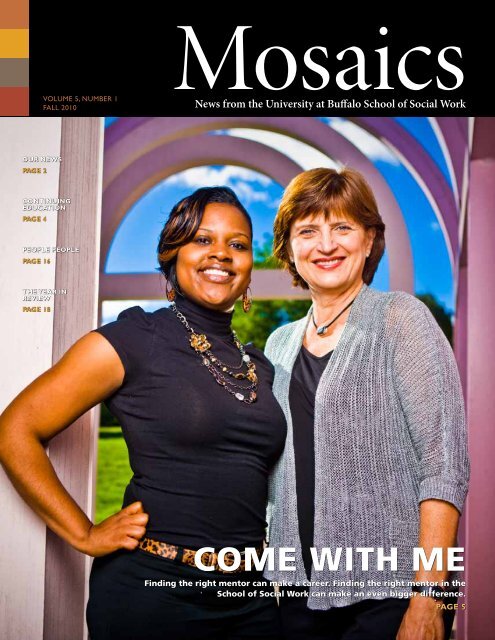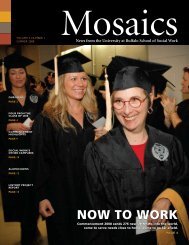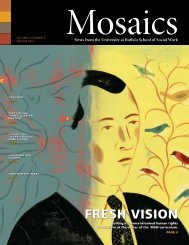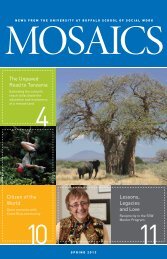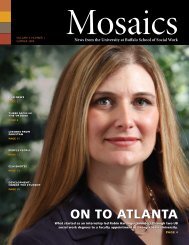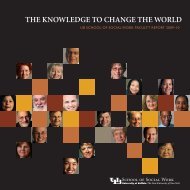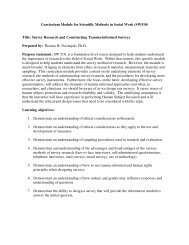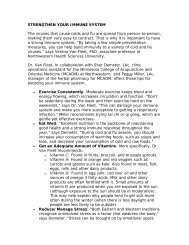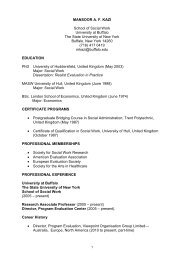come with me - UB School of Social Work - University at Buffalo
come with me - UB School of Social Work - University at Buffalo
come with me - UB School of Social Work - University at Buffalo
Create successful ePaper yourself
Turn your PDF publications into a flip-book with our unique Google optimized e-Paper software.
Mosaics<br />
Volu<strong>me</strong> 5, Number 1<br />
Fall 2010<br />
Mosaics<br />
News from the <strong>University</strong> <strong>at</strong> <strong>Buffalo</strong> <strong>School</strong> <strong>of</strong> <strong>Social</strong> <strong>Work</strong><br />
Our news<br />
page 2<br />
Continuing<br />
educ<strong>at</strong>ion<br />
page 4<br />
people people<br />
page 16<br />
The year in<br />
review<br />
page 18<br />
<strong>co<strong>me</strong></strong> <strong>with</strong> <strong>me</strong><br />
Finding the right <strong>me</strong>ntor can make a career. Finding the right <strong>me</strong>ntor in the<br />
<strong>School</strong> <strong>of</strong> <strong>Social</strong> <strong>Work</strong> can make an even bigger difference.<br />
page 5<br />
mosaics : Winter 2010 1
Mosaics<br />
Mosaics, the newsletter <strong>of</strong> the <strong>UB</strong><br />
<strong>School</strong> <strong>of</strong> <strong>Social</strong> <strong>Work</strong>, is produced<br />
three ti<strong>me</strong>s a year by the Office <strong>of</strong> <strong>University</strong><br />
Communic<strong>at</strong>ions, Division <strong>of</strong><br />
External Affairs. November 2010.<br />
10-SOC-002.<br />
www.socialwork.buffalo.edu<br />
The <strong>University</strong> <strong>at</strong> <strong>Buffalo</strong> is a premier<br />
research-intensive public university, the<br />
largest and most comprehensive campus<br />
in the St<strong>at</strong>e <strong>University</strong> <strong>of</strong> New York.<br />
<strong>UB</strong>’s more than 28,000 students pursue<br />
their academic interests through more<br />
than 375 undergradu<strong>at</strong>e, gradu<strong>at</strong>e and<br />
pr<strong>of</strong>essional degree programs. Founded<br />
in 1846, the <strong>University</strong> <strong>at</strong> <strong>Buffalo</strong> is a<br />
<strong>me</strong>mber <strong>of</strong> the Associ<strong>at</strong>ion <strong>of</strong> A<strong>me</strong>rican<br />
Universities.<br />
editorial team<br />
Barbara Rittner<br />
Associ<strong>at</strong>e Dean for External Affairs<br />
<strong>School</strong> <strong>of</strong> <strong>Social</strong> <strong>Work</strong><br />
Jud Mead<br />
Newsletters Coordin<strong>at</strong>or<br />
Office <strong>of</strong> <strong>University</strong> Communic<strong>at</strong>ions<br />
Design<br />
Nick Peterson<br />
Office <strong>of</strong> <strong>University</strong> Communic<strong>at</strong>ions<br />
Cover Photo: Douglas Levere<br />
Our News<br />
Faculty and students present<br />
far and wide<br />
Members <strong>of</strong> the <strong>School</strong> <strong>of</strong> <strong>Social</strong> <strong>Work</strong> faculty<br />
continue to present widely <strong>at</strong> regional,<br />
n<strong>at</strong>ional and intern<strong>at</strong>ional conferences.<br />
Mansoor Kazi presented <strong>at</strong> the 2010<br />
Joint World Conference on <strong>Social</strong> <strong>Work</strong> and<br />
<strong>Social</strong> Develop<strong>me</strong>nt in Hong Kong and then<br />
<strong>at</strong> the Intern<strong>at</strong>ional Conference on Interdisciplinary<br />
<strong>Social</strong> Sciences <strong>at</strong> <strong>University</strong> <strong>of</strong><br />
Cambridge in the United Kingdom, where he<br />
was joined by doctoral students Nicole Tomasello<br />
(MSW ’02) and Shraddha Prabhu.<br />
Laura Lewis (MSW ’94), director <strong>of</strong> field<br />
educ<strong>at</strong>ion, and Mansoor Kazi presented <strong>at</strong><br />
the Seventh Intern<strong>at</strong>ional Conference on<br />
Evalu<strong>at</strong>ion for Practice in Elgin, Scotland.<br />
North <strong>of</strong> the border, Filo<strong>me</strong>na Critelli<br />
(MSW ’77) talked about health care in Cuba<br />
<strong>at</strong> the <strong>University</strong> <strong>of</strong> Toronto’s L<strong>at</strong>in A<strong>me</strong>rican<br />
Studies Speakers Series. In October,<br />
Deborah Waldrop presented her findings<br />
on end-<strong>of</strong>-life care <strong>at</strong> the 18th Intern<strong>at</strong>ional<br />
Congress on Palli<strong>at</strong>ive Care in Montreal. In<br />
November, Denise Krause and Susan Green<br />
(MSW ’88) will present <strong>at</strong> the Intern<strong>at</strong>ional<br />
Solution Focused Brief Therapy Associ<strong>at</strong>ion<br />
conference in Banff, Alberta. Also in<br />
November in Montreal, Susan Green, Tom<br />
Nochajski and Barbara Rittner, along <strong>with</strong><br />
doctoral students Whitney Mendel (MSW<br />
’02), Bincy Wilson and Molly Wolf (MSW<br />
’07), will be presenting <strong>at</strong> the Intern<strong>at</strong>ional<br />
Society <strong>of</strong> Traum<strong>at</strong>ic Stress Studies.<br />
In the U.S., the school was well represented<br />
by faculty and students <strong>at</strong> the n<strong>at</strong>ional conferences<br />
<strong>of</strong> both the Council on <strong>Social</strong> <strong>Work</strong><br />
Educ<strong>at</strong>ion and the Society for <strong>Social</strong> <strong>Work</strong><br />
and Research. Faculty presenters <strong>at</strong> the two<br />
conferences included Howard Doueck, Susan<br />
Green, Robert Keefe, Wooksoo Kim, K<strong>at</strong>hleen<br />
Kost, Denise Krause, Tom Nochajski,<br />
Kelly P<strong>at</strong>terson, Barbara Rittner, Adjoa Robinson<br />
and Hilary Weaver, and staff <strong>me</strong>mbers<br />
Laura Lewis (field educ<strong>at</strong>ion), Steven Sturman<br />
(instructional technology) and Shirley<br />
Reiser (MSW ’76) (Rochester coordin<strong>at</strong>or).<br />
Tom Nochajski and doctoral student<br />
Molly Wolf received an award for their poster<br />
present<strong>at</strong>ion <strong>at</strong> the Intern<strong>at</strong>ional Society<br />
for the Study <strong>of</strong> Trauma and Dissoci<strong>at</strong>ion in<br />
Washington, D.C. Laina Bay-Cheng <strong>at</strong>tended<br />
the Society for Research on Adolescence<br />
Biennial Meeting in Philadelphia, Pa. Barbara<br />
Rittner was an invited presenter <strong>at</strong> the<br />
Baccalaure<strong>at</strong>e Program Directors <strong>me</strong>eting in<br />
Atlanta, Ga.; she and doctoral student Bincy<br />
Wilson <strong>at</strong>tended the seventh annual Intern<strong>at</strong>ional<br />
Conference on Human Trafficking,<br />
Prostitution, and Sex <strong>Work</strong> in Toledo, Ohio.<br />
Wilson will present <strong>at</strong> the A<strong>me</strong>rican Evalu<strong>at</strong>ion<br />
Associ<strong>at</strong>ion Conference in Orlando,<br />
Fla., <strong>with</strong> Tom Nochajski; Mansoor Kazi<br />
will also present <strong>at</strong> th<strong>at</strong> conference. Wooksoo<br />
Kim and doctoral student Ya-Ling Chen<br />
will be present <strong>at</strong> the Gerontological Society<br />
<strong>of</strong> A<strong>me</strong>rica’s 63rd annual Scientific Meeting<br />
in New Orleans, La.<br />
Doctoral students are also presenting<br />
<strong>at</strong> n<strong>at</strong>ional and intern<strong>at</strong>ional conferences<br />
on their own: John Dlugosz (MSW<br />
’08) presented <strong>at</strong> the Sixth Intern<strong>at</strong>ional<br />
Interdisciplinary Conference on Clinical<br />
Supervision in Garden City, N.Y. Doyle<br />
Pruitt presented <strong>at</strong> the A<strong>me</strong>rican Evalu<strong>at</strong>ion<br />
Associ<strong>at</strong>ion Conference, in Orlando, Fla.<br />
Savra Frounfelker presented <strong>at</strong> the Hawaii<br />
Intern<strong>at</strong>ional Conference on <strong>Social</strong> Sciences.<br />
Elaine Rinfrette (PhD ’10) presented <strong>at</strong> the<br />
Alzhei<strong>me</strong>r’s Associ<strong>at</strong>ion in Rochester, N.Y.,<br />
as well as the Ethnographic and Qualit<strong>at</strong>ive<br />
Research Conference in Cedarville, Ohio.<br />
2 mosaics : winter Fall 2010 2010
From Dean<br />
Nancy J. Smyth<br />
SSW na<strong>me</strong>s in the news<br />
Deborah Waldrop has been invited by the<br />
<strong>Social</strong> <strong>Work</strong> Policy Institute to be part <strong>of</strong> a<br />
think tank on hospice care. Mansoor Kazi<br />
received a gold-level award for excellence<br />
in evalu<strong>at</strong>ion from the Substance Abuse<br />
and Mental Health Services Administr<strong>at</strong>ion<br />
(SAMHSA) for his work in Chautauqua<br />
County. Nancy Kusmaul was selected to be<br />
among the first cohort <strong>of</strong> the Associ<strong>at</strong>ion for<br />
Gerontology Educ<strong>at</strong>ion in <strong>Social</strong> <strong>Work</strong>’s Gerontological<br />
<strong>Social</strong> <strong>Work</strong> Pre-Dissert<strong>at</strong>ion<br />
Initi<strong>at</strong>ive. Molly Wolf, doctoral candid<strong>at</strong>e,<br />
received a David Caul Dissert<strong>at</strong>ion Research<br />
Grant from the Intern<strong>at</strong>ional Society for the<br />
Study <strong>of</strong> Trauma and Dissoci<strong>at</strong>ion.<br />
NASW 2010 Congress<br />
and CSWE<br />
Barbara Rittner was among the 400 n<strong>at</strong>ional<br />
social work leaders invited to the N<strong>at</strong>ional<br />
Associ<strong>at</strong>ion <strong>of</strong> <strong>Social</strong> <strong>Work</strong>ers (NASW)<br />
2010 <strong>Social</strong> <strong>Work</strong> Congress in April in<br />
Washington, D.C. The congress explored a<br />
variety <strong>of</strong> issues critical to the future <strong>of</strong> the<br />
pr<strong>of</strong>ession, including the pr<strong>of</strong>essional use <strong>of</strong><br />
technology, business and manage<strong>me</strong>nt<br />
practices for sustainable services, recruit<strong>me</strong>nt<br />
into the pr<strong>of</strong>ession and expanding<br />
SSW faculty <strong>me</strong>mber cries foul<br />
interorganiz<strong>at</strong>ional collabor<strong>at</strong>ion opportunities.<br />
The discussions produced 10<br />
imper<strong>at</strong>ives th<strong>at</strong> can be found on the NASW<br />
website. Rittner has also been appointed<br />
to the Council on <strong>Social</strong> <strong>Work</strong> Educ<strong>at</strong>ion<br />
(CSWE) board <strong>of</strong> directors as the leadership<br />
forum represent<strong>at</strong>ive; she joins faculty colleague<br />
Diane Elze in CSWE leadership.<br />
Speaker knocks down<br />
assumptions<br />
Robert Whitaker, the school’s spring 2010<br />
Distinguished Speaker, is a gifted author<br />
who challenges the way pr<strong>of</strong>essionals think<br />
about <strong>me</strong>ntal health tre<strong>at</strong><strong>me</strong>nt. Whitaker<br />
presented a thought-provoking argu<strong>me</strong>nt,<br />
supported <strong>with</strong> current research, th<strong>at</strong> much<br />
<strong>of</strong> the <strong>me</strong>dic<strong>at</strong>ion given to people <strong>with</strong> severe<br />
and persistent <strong>me</strong>ntal illness may make<br />
them less functional over ti<strong>me</strong>.<br />
Roll Out the Red Carpet<br />
On May 24, 2010, Living Pro<strong>of</strong>: 75 years <strong>of</strong><br />
<strong>Social</strong> <strong>Work</strong> aired in the <strong>Buffalo</strong>-Niagara<br />
area on public television st<strong>at</strong>ion WNED.<br />
The video tells the story <strong>of</strong> the <strong>School</strong> <strong>of</strong><br />
<strong>Social</strong> <strong>Work</strong> from its founding to the present<br />
and its connections to the sociopolitical<br />
history <strong>of</strong> the country.<br />
Who knew? Susan Green, clinical associ<strong>at</strong>e<br />
pr<strong>of</strong>essor, has been a pr<strong>of</strong>essional<br />
wo<strong>me</strong>n’s basketball referee for 27 years <strong>at</strong><br />
the scholastic and collegi<strong>at</strong>e levels. This<br />
year she refereed four wo<strong>me</strong>n’s basketball<br />
tourna<strong>me</strong>nt ga<strong>me</strong>s, including the bronze <strong>me</strong>dal ga<strong>me</strong> <strong>at</strong> the prestigious New York’s Empire<br />
St<strong>at</strong>e Ga<strong>me</strong>s, one <strong>of</strong> the largest competitions <strong>of</strong> its kind in the n<strong>at</strong>ion.<br />
A wonderful <strong>me</strong>ntor made all the difference<br />
for <strong>me</strong> in my gradu<strong>at</strong>e work. In<br />
fact, I wouldn’t have pursued my doctor<strong>at</strong>e<br />
if it hadn’t been for the encourage<strong>me</strong>nt<br />
<strong>of</strong> my <strong>me</strong>ntor. Mentorship can<br />
be many things—in the context <strong>of</strong> an<br />
academic institution, especially a pr<strong>of</strong>essional<br />
school, it will rel<strong>at</strong>e to guiding<br />
students in the develop<strong>me</strong>nt <strong>of</strong> their<br />
pr<strong>of</strong>essional selves. The rel<strong>at</strong>ionship<br />
<strong>of</strong>ten integr<strong>at</strong>es the personal and pr<strong>of</strong>essional,<br />
since human beings don’t keep<br />
their lives in simple boxes. Understanding<br />
how to balance my personal and<br />
pr<strong>of</strong>essional lives and how to integr<strong>at</strong>e<br />
my personal and pr<strong>of</strong>essional selves was<br />
part <strong>of</strong> wh<strong>at</strong> my <strong>me</strong>ntor gave to <strong>me</strong>.<br />
This is especially important in a pr<strong>of</strong>ession<br />
like social work, where effective use<br />
<strong>of</strong> self can be critical to success in working<br />
<strong>with</strong> clients, teaching, administering<br />
programs and conducting research.<br />
The influence <strong>of</strong> a <strong>me</strong>ntor can last for<br />
many years; wh<strong>at</strong> is truly gr<strong>at</strong>ifying is<br />
to see how students take this influence<br />
and transform it into so<strong>me</strong>thing <strong>of</strong> their<br />
own, and, in turn, be<strong>co<strong>me</strong></strong> <strong>me</strong>ntors for<br />
others. This issue highlights so<strong>me</strong> <strong>of</strong> the<br />
<strong>me</strong>ntoring th<strong>at</strong> takes place in the school.<br />
As we have added more faculty, our capacity<br />
for <strong>me</strong>ntoring has increased, and<br />
the diversity <strong>of</strong> experiences has be<strong>co<strong>me</strong></strong><br />
richer. Going forward, as we work to<br />
“right size” the faculty, this capacity and<br />
its impact will increase even more.<br />
Nancy J. Smyth, PhD, LCSW<br />
mosaics : Winter : fall 2010 3
Maximize Your Life Potential<br />
Continuing educ<strong>at</strong>ion is the way to grow<br />
When was the last ti<strong>me</strong> so<strong>me</strong>one asked you, “Wh<strong>at</strong> have you<br />
learned recently th<strong>at</strong> made a difference in your life or in so<strong>me</strong>one<br />
else’s life?” When have you gone on a job interview and so<strong>me</strong>one<br />
asked you to define your destiny and how you planned to achieve<br />
it? Those are the kinds <strong>of</strong> questions asked by Lesa Fichte, director<br />
<strong>of</strong> continuing educ<strong>at</strong>ion.<br />
The continuing educ<strong>at</strong>ion instructors who teach and inspire<br />
us are our <strong>me</strong>ntors, our guides. We may only interface <strong>with</strong> them<br />
for a day or we may develop an ongoing rel<strong>at</strong>ionship <strong>with</strong> them<br />
through repe<strong>at</strong>ed trainings, clinical supervision or connections<br />
through Facebook, Twitter or Linked-In. They make a difference<br />
in our life so th<strong>at</strong> we can make a difference in so<strong>me</strong>one else’s life.<br />
As everyone knows, social work isn’t just a career. It’s a<br />
passion to help people and communities improve their quality <strong>of</strong><br />
life. And it’s also a brain ga<strong>me</strong>. Our brains need to learn in order<br />
to grow and remain healthy, keeping our brain cells functioning<br />
<strong>at</strong> optimum levels. Commit<strong>me</strong>nt to lifelong learning is an act <strong>of</strong><br />
self-care. Our stress is reduced because we have more tools and<br />
skills to work in challenging organiz<strong>at</strong>ional settings and <strong>with</strong><br />
clients who have complex needs. Serving others to the best <strong>of</strong> our<br />
ability requires th<strong>at</strong> we know more than just wh<strong>at</strong> we learned in<br />
gradu<strong>at</strong>e school.<br />
The Office <strong>of</strong> Continuing Educ<strong>at</strong>ion is committed to helping<br />
our alumni and other human service pr<strong>of</strong>essionals maximize<br />
their potential. To quote Gandhi, “Live as if you were to die<br />
tomorrow. Learn as if you were to live forever.”<br />
Many people ask about wh<strong>at</strong> plans we have for the future.<br />
As part <strong>of</strong> our Trauma Counseling Certific<strong>at</strong>e Program, we are<br />
currently working on plans to cre<strong>at</strong>e a core <strong>of</strong> trauma workshops<br />
available online. We have two available this fall: The first is<br />
Overview <strong>of</strong> the N<strong>at</strong>ure and Tre<strong>at</strong><strong>me</strong>nt <strong>of</strong> Trauma, fe<strong>at</strong>uring our<br />
dean, Nancy Smyth, and faculty <strong>me</strong>mber Sue Green; the other is<br />
Evidence-based Methods for Trauma Tre<strong>at</strong><strong>me</strong>nt, which Green<br />
has just fil<strong>me</strong>d as an online workshop. Our goal is to cre<strong>at</strong>e a core<br />
<strong>of</strong> online workshops th<strong>at</strong> give people a found<strong>at</strong>ion <strong>of</strong> knowledge<br />
about trauma.<br />
We kicked <strong>of</strong>f our fall training season in September <strong>with</strong><br />
Ricky Greenwald, PsyD, founder and executive director <strong>of</strong> the<br />
Trauma Institute and Child Trauma Institute in Greenfield,<br />
Mass., <strong>with</strong> his Trauma Infor<strong>me</strong>d Tre<strong>at</strong><strong>me</strong>nt: The Fairy Tale<br />
Mode. He trained more than 70 clinicians to help them improve<br />
their skills in working <strong>with</strong> adults and children who have been<br />
exposed to significant trauma or loss. New trainer Peggy L.<br />
Kolodny, MA, CPC, a board-certified and registered art therapist<br />
from Baltimore, Md., brought us the fabulous Overview <strong>of</strong><br />
Trauma Focused Art Therapy. She had people quickly engaged<br />
using pastels and other <strong>me</strong>dia to learn techniques they could im<strong>me</strong>di<strong>at</strong>ely<br />
put into practice.<br />
As financial manage<strong>me</strong>nt is a major issue for many <strong>of</strong> our<br />
clients, continuing educ<strong>at</strong>ion staff tea<strong>me</strong>d up <strong>with</strong> <strong>UB</strong> alumni<br />
Diane Bessel, PhD, LMSW, and K<strong>at</strong>ie Lyons, MSW, to <strong>of</strong>fer<br />
Empowering Clients to Improve their Rel<strong>at</strong>ionships <strong>with</strong> Money.<br />
The Depart<strong>me</strong>ntal and Research Administr<strong>at</strong>ors Develop<strong>me</strong>nt<br />
Series kicks <strong>of</strong>f in November and will <strong>of</strong>fer three workshops<br />
through May 2011. The series targets depart<strong>me</strong>ntal and research<br />
administr<strong>at</strong>ors, project directors, managers and principal investig<strong>at</strong>ors<br />
who want to advance their skills in a variety <strong>of</strong> research<br />
environ<strong>me</strong>nts.<br />
Spring and sum<strong>me</strong>r 2011 planning is under way. Save the<br />
d<strong>at</strong>e as the amazing Bill O’Hanlon, MS, LMFT, will be in <strong>Buffalo</strong><br />
on July 21 for our 26th annual Sum<strong>me</strong>r<br />
Institute. Bill is well known as an<br />
intern<strong>at</strong>ional trainer for his storytelling,<br />
irreverent humor, clear and accessible<br />
style, and his boundless enthusiasm<br />
for wh<strong>at</strong>ever he is doing. He will <strong>of</strong>fer<br />
a one-day workshop on Resolving<br />
Trauma Without Drama: New, Brief,<br />
Respectful and Effective Approaches to<br />
O’Hanlon<br />
Tre<strong>at</strong>ing Post-Traum<strong>at</strong>ic Stress Disorder.<br />
Director Lesa Fichte is always looking for important<br />
topics and expert trainers. Contact her <strong>at</strong> llfichte@buffalo.edu<br />
or 716-829-5847 to share your suggestions.<br />
4 mosaics : Fall 2010
The good fortune <strong>of</strong> finding a <strong>me</strong>ntor<br />
Of all the enterprises the <strong>School</strong> <strong>of</strong> <strong>Social</strong> <strong>Work</strong> engages<br />
in, teaching is primary. Before research or scholarship<br />
or community engage<strong>me</strong>nt or pr<strong>of</strong>essional leadership,<br />
teaching—cre<strong>at</strong>ing in students the body <strong>of</strong> knowledge and<br />
understanding they need for pr<strong>of</strong>essional practice and further<br />
learning—is the school’s most important work.<br />
The teaching-learning transaction is a crucible th<strong>at</strong> holds as<br />
many different reactions as there are people engaged. The<br />
school is a universe <strong>of</strong> those reactions flickering through the<br />
year. Regularly, almost inevitably, so<strong>me</strong> grow strong enough<br />
to turn a teacher into a <strong>me</strong>ntor for a particular student. Such<br />
rel<strong>at</strong>ionships, <strong>with</strong> their additional di<strong>me</strong>nsions <strong>of</strong> guidance<br />
and counsel, can be life-shaping.<br />
Here are the stories <strong>of</strong> five such connections, <strong>of</strong> students and<br />
the teachers who beca<strong>me</strong> their <strong>me</strong>ntors.<br />
Mentors<br />
The difference they make<br />
Stories by Charlotte Hsu, Jim Bisco and Judson Mead<br />
Photos by Douglas Levere<br />
mosaics : fall 2010 5
Charles Syms<br />
and Milly Colón<br />
6 mosaics : fall 2010
He showed the way<br />
So<strong>me</strong>how, their p<strong>at</strong>hs always crossed. Milly Colón, MSW ’01, <strong>me</strong>t Charles Syms<br />
for the first ti<strong>me</strong> in the mid-1980s, when she interviewed him as part <strong>of</strong> a class assign<strong>me</strong>nt.<br />
She was an undergradu<strong>at</strong>e studying social work <strong>at</strong> <strong>Buffalo</strong> St<strong>at</strong>e College. He was a clinical<br />
specialist <strong>with</strong> Erie County Child Protective Services. The encounter made a lasting impression<br />
on Colón. As both were persons <strong>of</strong> color, she saw him as a role model.<br />
Syms, now a clinical associ<strong>at</strong>e pr<strong>of</strong>essor<br />
in the <strong>School</strong> <strong>of</strong> <strong>Social</strong> <strong>Work</strong>, doesn’t re<strong>me</strong>mber<br />
th<strong>at</strong> encounter. But in the years th<strong>at</strong> followed, he<br />
and Colón would <strong>me</strong>et again and again. They saw<br />
each other during pr<strong>of</strong>essional trainings and occasionally<br />
they shared clients. She struck him as a leader—so<strong>me</strong>one<br />
who worked hard and cared, genuinely, about the people<br />
who sought her help.<br />
So after joining the faculty <strong>at</strong> <strong>UB</strong>, Syms encouraged<br />
Colón to pursue her MSW. “You can do it,” he told her,<br />
even if she was a mother raising three young daughters<br />
and working full ti<strong>me</strong>. He advised her th<strong>at</strong> an MSW<br />
would open doors in her career, providing her <strong>with</strong> the<br />
background she needed to advance <strong>at</strong> Lake Shore Behavioral<br />
Health, an organiz<strong>at</strong>ion th<strong>at</strong> tre<strong>at</strong>s individuals <strong>with</strong><br />
<strong>me</strong>ntal health and chemical abuse disorders.<br />
“It was pretty aweso<strong>me</strong>. It was pretty powerful for him<br />
to encourage <strong>me</strong> in th<strong>at</strong> way, you know?” Colón says. “I<br />
can’t even begin to put words to it. He doesn’t even really<br />
know how much th<strong>at</strong> <strong>me</strong>ant.<br />
“Charlie’s a big proponent <strong>of</strong> higher educ<strong>at</strong>ion,” she<br />
adds. “Throughout the years <strong>of</strong> our pr<strong>of</strong>essional contact,<br />
he just kept talking about it: ‘You gotta go back to school.<br />
You gotta go back to school.’ I really did not have a<br />
choice once he was teaching <strong>at</strong> <strong>UB</strong>. I had to go. I believe<br />
it was <strong>me</strong>ant for <strong>me</strong> to <strong>me</strong>et him and for our pr<strong>of</strong>essional<br />
p<strong>at</strong>hs to continue to cross, so th<strong>at</strong> I would have the support<br />
I needed to succeed in school.”<br />
Completing the MSW program was a struggle. At<br />
Syms’ urging, Colón chose to specialize in policy, planning<br />
and administr<strong>at</strong>ion in social work instead <strong>of</strong> in substance<br />
abuse, the area in which she had already worked<br />
for many years. Choosing to concentr<strong>at</strong>e on less familiar<br />
subject m<strong>at</strong>ter would enable her to expand her base <strong>of</strong><br />
knowledge. But it would also be a challenge.<br />
Balancing school <strong>with</strong> work and parenting left Colón<br />
exhausted. Many days, she wondered how she would be<br />
able to finish the program. At those ti<strong>me</strong>s, Syms’ support<br />
continued to keep her focused. She never took a class<br />
<strong>with</strong> Syms, but she would so<strong>me</strong>ti<strong>me</strong>s call him or drop by<br />
his <strong>of</strong>fice.<br />
“When it got tough and I didn’t want to write one<br />
more paper, didn’t want to research one more thing,<br />
Charlie and other pr<strong>of</strong>essors and staff I had regular<br />
contact <strong>with</strong>, they just continued to say, ‘Yes you can.’ For<br />
myself, th<strong>at</strong> made the difference.” Syms <strong>at</strong>tended Colón’s<br />
gradu<strong>at</strong>ion.<br />
And since then, their careers have continued to bring<br />
them together. For several years, they served on a credentialing<br />
advisory board <strong>of</strong> the st<strong>at</strong>e Office <strong>of</strong> Alcoholism<br />
and Substance Abuse Services. The <strong>me</strong>etings were in<br />
Albany, and they carpooled. Colón took advantage <strong>of</strong> the<br />
long drives to ask Syms for advice on specific client cases<br />
or other issues.<br />
For Colón, the MSW paid <strong>of</strong>f: Lake Shore Behavioral<br />
Health promoted her to be<strong>co<strong>me</strong></strong> director <strong>of</strong> two outp<strong>at</strong>ient<br />
addiction tre<strong>at</strong><strong>me</strong>nt programs. Now, she is program director<br />
<strong>of</strong> the organiz<strong>at</strong>ion’s Lighthouse Wo<strong>me</strong>n’s Residence.<br />
Th<strong>at</strong> Syms doesn’t re<strong>me</strong>mber their first contact is an<br />
enjoyable irony for Colón. He inspired her then, and<br />
remains an inspir<strong>at</strong>ion now.<br />
“I saw him as a pioneer,” she says. “He was just one<br />
<strong>of</strong> a handful <strong>of</strong> people <strong>of</strong> color working in th<strong>at</strong> system.<br />
And he was in a supervisory position. Seeing th<strong>at</strong>, I<br />
thought, ‘OK, people <strong>of</strong> color can, in fact, move in certain<br />
directions and make an impact and move along the career<br />
ladder.’ Th<strong>at</strong> was why it left such a lasting impression<br />
on <strong>me</strong>.” —C.H.<br />
mosaics : fall 2010 7
A GUIDE ON THE PATH<br />
As a nurse in pedi<strong>at</strong>ric intensive care, Elaine Rinfrette beca<strong>me</strong> increasingly<br />
symp<strong>at</strong>hetic to the effects <strong>of</strong> trauma on p<strong>at</strong>ients’ families. “It was a very stressful environ<strong>me</strong>nt.<br />
The p<strong>at</strong>ients were well cared for, but the families were really struggling,” she re<strong>me</strong>mbers.<br />
“In th<strong>at</strong> process, I beca<strong>me</strong> more aware <strong>of</strong> wh<strong>at</strong> social workers did to try to help families get<br />
through th<strong>at</strong> ti<strong>me</strong> and th<strong>at</strong> really appealed to <strong>me</strong>.”<br />
The Rhode Island n<strong>at</strong>ive decided to change<br />
careers. She earned an MSW <strong>at</strong> Boston <strong>University</strong><br />
and then worked in outp<strong>at</strong>ient tre<strong>at</strong><strong>me</strong>nt for<br />
<strong>me</strong>ntal health and substance abuse for the next 19<br />
years, most <strong>of</strong> them in <strong>Buffalo</strong> where she had moved<br />
<strong>with</strong> her partner.<br />
Then she found herself <strong>at</strong> another crossroads.<br />
“There ca<strong>me</strong> a point in my life when I felt th<strong>at</strong> I had<br />
learned a lot, had a lot <strong>of</strong> experience and thought<br />
so<strong>me</strong> <strong>of</strong> th<strong>at</strong> might be valuable to the next gener<strong>at</strong>ion<br />
coming up in the field.”<br />
She dipped her toe in more gradu<strong>at</strong>e work by<br />
taking Nancy Smyth’s course in trauma. Smyth encouraged<br />
her to enroll in the PhD program.<br />
Then ca<strong>me</strong> one more turn in her p<strong>at</strong>h.<br />
Rinfrette was referred to associ<strong>at</strong>e pr<strong>of</strong>essor Deborah<br />
Waldrop for an internship in the area <strong>of</strong> aging.<br />
“It wasn’t an im<strong>me</strong>di<strong>at</strong>e m<strong>at</strong>ch so I wondered how this<br />
is going to work. I was used to thinking about trauma<br />
in a much narrower way—mostly childhood sexual or<br />
physical abuse and do<strong>me</strong>stic violence,” Rinfrette says.<br />
“But this opened up another whole new area th<strong>at</strong> I<br />
hadn’t really thought about.”<br />
Waldrop recalls Rinfrette approaching her skeptically.<br />
They discussed the experience <strong>of</strong> trauma in<br />
various popul<strong>at</strong>ions. “Wh<strong>at</strong> I <strong>of</strong>fered her was the<br />
possibility <strong>of</strong> analyzing interview transcripts th<strong>at</strong> I had<br />
done <strong>with</strong> families <strong>of</strong> hospice p<strong>at</strong>ients th<strong>at</strong> incorpor<strong>at</strong>ed<br />
a gre<strong>at</strong> deal <strong>of</strong> traum<strong>at</strong>ic experience,” Waldrop says.<br />
“As she read along in these very difficult situ<strong>at</strong>ions, she<br />
recognized she was seeing another type <strong>of</strong> trauma th<strong>at</strong><br />
she hadn’t really considered. They were very moving<br />
stories. She said, ‘I can’t get this out <strong>of</strong> my head.’”<br />
Rinfrette credits Waldrop for giving her a perspective<br />
on aging she had never considered. In Waldrop’s<br />
words, “Aging is a verb, not just a noun. We’re not just<br />
talking about people who are 85 or older. We’re talking<br />
about people aging across their life span.” Now<br />
Rinfrette could see trauma as so<strong>me</strong>thing th<strong>at</strong> happens<br />
along the life course.<br />
She began to look <strong>at</strong> the variety <strong>of</strong> popul<strong>at</strong>ions<br />
along the aging p<strong>at</strong>h. Her doctoral dissert<strong>at</strong>ion centered<br />
on families in which one <strong>me</strong>mber develops earlyonset<br />
Alzhei<strong>me</strong>r’s disease—a popul<strong>at</strong>ion th<strong>at</strong> has been<br />
little studied. “The people I interviewed got their first<br />
diagnosis either in their l<strong>at</strong>e 40s or early 50s, which<br />
is really frightening to think about. Hardly anything<br />
has been explored about how to <strong>me</strong>et such a person’s<br />
needs and the needs in the families th<strong>at</strong> take care <strong>of</strong><br />
them,” Rinfrette says.<br />
Waldrop believes th<strong>at</strong> doctoral study is a way to<br />
discover unseen possibility.<br />
“I think it has opened up an incredible opportunity<br />
for Elaine,” she says. “She’s looking <strong>at</strong> a popul<strong>at</strong>ion<br />
th<strong>at</strong> is so marginalized and understudied. We don’t<br />
know wh<strong>at</strong> they go through. So wh<strong>at</strong> she’s got to <strong>of</strong>fer<br />
the world is a first look <strong>at</strong> thinking about this diagnosis<br />
and the experience <strong>of</strong> caregiving through the lens <strong>of</strong><br />
trauma.”<br />
Rinfrette finished her doctor<strong>at</strong>e this spring and is<br />
seeking an academic position where she can teach<br />
and continue her research. In the <strong>me</strong>anti<strong>me</strong>, she is<br />
working <strong>at</strong> the school on a temporary basis, teaching<br />
and conducting interviews for Waldrop’s current study<br />
on hospice p<strong>at</strong>ients.<br />
Rinfrette says the work has opened her eyes to the<br />
value <strong>of</strong> qualit<strong>at</strong>ive research: “In the interviews I’ve<br />
done, people say, ‘Thank you for listening to <strong>me</strong>. It has<br />
really helped <strong>me</strong> process my grief.’ In addition to the<br />
research component, it’s got a therapeutic component,<br />
which for <strong>me</strong> fits well because <strong>of</strong> the tre<strong>at</strong><strong>me</strong>nt I did for<br />
so long.” —J.B.<br />
8 mosaics : fall 2010
Elaine rinfrette<br />
and Deborah waldrop<br />
mosaics : fall 2010<br />
9
Robert keefe<br />
and Whitney Mendel<br />
10 mosaics : fall 2010
Let <strong>me</strong> introduce you<br />
when Rob Keefe, now an associ<strong>at</strong>e pr<strong>of</strong>essor <strong>at</strong> the <strong>School</strong> <strong>of</strong> <strong>Social</strong> <strong>Work</strong>,<br />
went to his first A<strong>me</strong>rican Public Health Associ<strong>at</strong>ion <strong>me</strong>eting in 1998, he wanted to see it<br />
all. He had a new PhD, a new faculty position <strong>at</strong> Syracuse <strong>University</strong>, he saw the APHA as<br />
a n<strong>at</strong>ural ho<strong>me</strong>—and <strong>at</strong> the <strong>me</strong>eting in Washington, D.C., <strong>with</strong> 12,000 <strong>at</strong>tendees, he got<br />
lost in the shuffle.<br />
He goes to the APHA annual <strong>me</strong>eting in Denver<br />
this year as chair-elect <strong>of</strong> the social work section.<br />
<strong>UB</strong> social work PhD student Whitney Mendel<br />
(MSW ’02) will go <strong>with</strong> him. It will be her first APHA<br />
<strong>me</strong>eting. Thanks to Keefe, she’ll already know her way<br />
around.<br />
Mendel had just gradu<strong>at</strong>ed from the MSW program<br />
when she delivered prem<strong>at</strong>ure twins. Her clinical interest<br />
and field training was in <strong>me</strong>dical social work; now she<br />
was the mother <strong>of</strong> infants struggling in a neon<strong>at</strong>al intensive<br />
care unit.<br />
She stayed <strong>at</strong> ho<strong>me</strong> <strong>with</strong> the twins. When they were<br />
school age, she was ready for more gradu<strong>at</strong>e study. She<br />
approached Keefe for guidance because his interest is<br />
<strong>me</strong>dical social work. She credits their convers<strong>at</strong>ion <strong>with</strong><br />
launching this stage <strong>of</strong> her academic career.<br />
Mendel had been volunteering in organiz<strong>at</strong>ions th<strong>at</strong><br />
tre<strong>at</strong> gravely ill infants and children or help their parents.<br />
She sits on the board <strong>of</strong> directors <strong>of</strong> the March <strong>of</strong> Di<strong>me</strong>s<br />
Western New York Division; she serves on committees <strong>at</strong><br />
Wo<strong>me</strong>n and Children’s Hospital <strong>of</strong> <strong>Buffalo</strong>.<br />
So when she and Keefe started their convers<strong>at</strong>ion, he<br />
<strong>me</strong>t so<strong>me</strong>one <strong>with</strong> a developed interest in the field who<br />
could move as an equal among busy pr<strong>of</strong>essionals in settings<br />
where <strong>me</strong>dical social work is practiced.<br />
He held an organiz<strong>at</strong>ional portfolio <strong>of</strong> his own. For the<br />
past several years, as he rose through the elected ranks <strong>of</strong><br />
the APHA’s social work section, Keefe had been the section’s<br />
annual <strong>me</strong>eting program planner. Th<strong>at</strong> work includes<br />
everything from setting the intellectual content for the <strong>me</strong>eting<br />
to setting the tables for dinner—or <strong>at</strong> least making sure<br />
every detail is arranged.<br />
The social work section is celebr<strong>at</strong>ing its 40th anniversary<br />
this year, although Keefe says it has actually been<br />
part <strong>of</strong> the APHA for 100 years, the first 60 as “sociology.”<br />
But the section is also literally aging: the average<br />
age <strong>of</strong> the <strong>me</strong>mbership is 48 so Keefe wants to recruit<br />
younger <strong>me</strong>mbers.<br />
He and his leadership colleagues started a <strong>me</strong>ntoring<br />
program to connect young academics <strong>with</strong> senior faculty<br />
<strong>me</strong>mbers, younger public health social workers <strong>with</strong><br />
commissioner-level public health <strong>of</strong>ficials. Section <strong>me</strong>mbers<br />
are also writing a book th<strong>at</strong> addresses the most pressing<br />
issues in public health social work. Springer will publish the<br />
volu<strong>me</strong> in May 2011.<br />
And, along <strong>with</strong> these initi<strong>at</strong>ives, he wanted to find<br />
and <strong>me</strong>ntor a younger <strong>me</strong>mber to take over the program<br />
planning responsibility and then stay.<br />
Mendel fit the pr<strong>of</strong>ile, especially because her organiz<strong>at</strong>ional<br />
work showed strong leadership potential. He knew<br />
from his own experience th<strong>at</strong> bringing her into program<br />
planning would connect her to leading researchers and<br />
practitioners around the U.S. With their shared interests,<br />
and his interest in her future as a researcher (he will chair<br />
her dissert<strong>at</strong>ion committee), he was happy to broker those<br />
connections.<br />
Mendel may be just a year into her doctoral work, still<br />
completing coursework, but she now is corresponding<br />
<strong>with</strong>, by her estim<strong>at</strong>e, 60-70 social work researchers. She<br />
says she’s learned to hold her own <strong>with</strong> deans <strong>of</strong> social<br />
work. “Rob gave <strong>me</strong> entrée,” she says, “and I’m navig<strong>at</strong>ing<br />
on my own, which is the way I like to learn.”<br />
She calls Keefe a “master networker” <strong>with</strong> a Rolodex<br />
in his head: “It took <strong>me</strong> a while to realize how connected<br />
he is.” Theirs is the kind <strong>of</strong> the senior-junior academic<br />
<strong>me</strong>ntoring connection Keefe hopes will bring new blood<br />
to the pr<strong>of</strong>essional ho<strong>me</strong> <strong>with</strong> which he is so deeply<br />
involved.<br />
This year, before the <strong>me</strong>eting, Mendel was anxious to<br />
get there, to see the event th<strong>at</strong> now fills five or six hotels<br />
and to <strong>me</strong>et the people she’d been working <strong>with</strong>. Next<br />
year, when Keefe and Mendel prepare for the APHA annual<br />
<strong>me</strong>eting, he as chair <strong>of</strong> the social work section and<br />
she as the program planner, Mendel will be fully fledged,<br />
flying on her own in the world <strong>of</strong> pr<strong>of</strong>essional academic<br />
service, the one where she hopes to settle. —J.M.<br />
mosaics : fall 2010<br />
11
Personal champion<br />
A couple years ago, Ebonesha Graham was fighting to make it through the<br />
<strong>School</strong> <strong>of</strong> <strong>Social</strong> <strong>Work</strong> MSW program. A resident <strong>of</strong> a Rochester suburb, she commuted<br />
to <strong>Buffalo</strong> for classes. She struggled under the weight <strong>of</strong> two jobs and an internship. Her<br />
schedule see<strong>me</strong>d super-human. But so<strong>me</strong>how, she pulled through.<br />
Today, Graham, MSW ’09, is a child protective<br />
services investig<strong>at</strong>or in Monroe County. Faculty<br />
<strong>me</strong>mbers credit her incredible determin<strong>at</strong>ion for<br />
her success; Graham says <strong>with</strong>out their compassion,<br />
she might never have made it. Sue Green, a clinical<br />
associ<strong>at</strong>e pr<strong>of</strong>essor, coached Graham through classes.<br />
Shirley Reiser (MSW ‘76), the <strong>School</strong> <strong>of</strong> <strong>Social</strong> <strong>Work</strong>’s<br />
Rochester program coordin<strong>at</strong>or, beca<strong>me</strong> a <strong>me</strong>ntor.<br />
“I know th<strong>at</strong> <strong>UB</strong> is a really big school, but it’s pr<strong>of</strong>essors<br />
like Sue Green and Shirley Reiser who really care<br />
th<strong>at</strong> got <strong>me</strong> through,” Graham says. “I didn’t get lost in<br />
the numbers.”<br />
Reiser, Graham’s field liaison, <strong>me</strong>t Graham <strong>at</strong> the<br />
start <strong>of</strong> her advanced year. Graham was passion<strong>at</strong>e<br />
about working <strong>with</strong> children and adolescents, and<br />
Reiser had placed Graham <strong>with</strong> an organiz<strong>at</strong>ion th<strong>at</strong>,<br />
among other services, supported after-school programs.<br />
After <strong>me</strong>eting Graham to discuss her progress in the<br />
field, however, Reiser realized so<strong>me</strong>thing wasn’t right.<br />
“When I asked Ebonesha how things were going,<br />
her initial response was vague and general,” Reiser<br />
re<strong>me</strong>mbers. “Ebonesha had always been very clear<br />
in her communic<strong>at</strong>ions <strong>with</strong> <strong>me</strong>. This was different.<br />
So<strong>me</strong>thing was wrong.”<br />
After discussing the place<strong>me</strong>nt <strong>with</strong> Graham and the<br />
field educ<strong>at</strong>or supervising the work, Reiser concluded<br />
th<strong>at</strong> the pairing was not a good m<strong>at</strong>ch. The supervisor<br />
had a strong track record, but her communic<strong>at</strong>ion style<br />
so<strong>me</strong>ti<strong>me</strong>s clashed <strong>with</strong> Graham’s. In addition,<br />
Graham was spending significant ti<strong>me</strong> conducting<br />
research for a grant applic<strong>at</strong>ion, and Reiser could see<br />
th<strong>at</strong> she wanted to develop clinical skills.<br />
Reiser assigned Graham to a new field educ<strong>at</strong>or.<br />
Together, the three worked <strong>with</strong> the agency to find tasks<br />
th<strong>at</strong> better fit Graham’s interests. Graham also transferred<br />
from the organiz<strong>at</strong>ion’s headquarters to an outlying site<br />
where she would have more direct contact <strong>with</strong> youth.<br />
“I don’t think I would have gradu<strong>at</strong>ed <strong>with</strong>out<br />
Shirley,” Graham says. “Seeing th<strong>at</strong> so<strong>me</strong>one cared<br />
enough to be concerned about <strong>me</strong> finishing the<br />
program—th<strong>at</strong> helped <strong>me</strong> to open up not just in my<br />
convers<strong>at</strong>ions <strong>with</strong> her, but also in my <strong>at</strong>titude toward<br />
my place<strong>me</strong>nt.”<br />
“Before she intervened, I looked <strong>at</strong> my place<strong>me</strong>nt like<br />
I was doing my ti<strong>me</strong>, and it took away from my educ<strong>at</strong>ion.<br />
Shirley helped <strong>me</strong> realize I wasn’t just doing ti<strong>me</strong>. I<br />
was actually connecting the skills <strong>of</strong> the classroom to the<br />
work I was doing and would be doing in the future.”<br />
As their rel<strong>at</strong>ionship grew, Graham began asking<br />
Reiser for advice on issues outside the place<strong>me</strong>nt. The<br />
academic and emotional support Reiser <strong>of</strong>fered helped<br />
Graham gain confidence. Graham learned to better<br />
express her feelings and needs. She beca<strong>me</strong> a strong<br />
advoc<strong>at</strong>e for herself and for clients, a crucial skill for<br />
social workers.<br />
And the more Graham revealed about her life, the<br />
more Reiser was impressed.<br />
“I re<strong>me</strong>mber one day I really listened to Ebonesha<br />
talk about her life, about all th<strong>at</strong> she was managing,<br />
and in th<strong>at</strong> mo<strong>me</strong>nt, I realized th<strong>at</strong> Ebonesha is an incredibly<br />
strong, resilient, m<strong>at</strong>ure woman,” Reiser says.<br />
“I was in awe <strong>of</strong> how well she managed her competing<br />
responsibilities.”<br />
Reiser and Graham <strong>me</strong>t for lunch so<strong>me</strong> ti<strong>me</strong> after<br />
Graham’s gradu<strong>at</strong>ion to reminisce and talk about lessons<br />
learned. They stay in contact and talk about jobs<br />
and careers.<br />
Reiser re<strong>me</strong>mbers how, in the 1970s, two community<br />
<strong>me</strong>ntors helped guide her through the <strong>UB</strong> MSW<br />
program. They connected her <strong>with</strong> resources and<br />
networking opportunities, sparked her interest in public<br />
policy and community organizing, and “nudged <strong>me</strong> to<br />
do things I didn’t have the confidence to do,” she says.<br />
“At the end <strong>of</strong> my gradu<strong>at</strong>e program, when I had<br />
been hired by my place<strong>me</strong>nt, I thanked my <strong>me</strong>ntor for<br />
the opportunities he gave <strong>me</strong>,” Reiser re<strong>me</strong>mbers. “He<br />
looked <strong>at</strong> <strong>me</strong> and said, ‘Now it’s your turn.’ So for <strong>me</strong>,<br />
<strong>me</strong>ntoring is giving back to the pr<strong>of</strong>ession. It’s the most<br />
gr<strong>at</strong>ifying part <strong>of</strong> my job. I learned a lot from Ebonesha,<br />
and I’m gr<strong>at</strong>eful for th<strong>at</strong>.” —C.H.<br />
12<br />
mosaics : fall 2010
Ebonesha graham<br />
and Shirley Reiser<br />
mosaics : fall 2010 13
C<strong>at</strong>herine Dulmus<br />
and Amy Manning<br />
14 mosaics : fall 2010
Mutual GOod<br />
C<strong>at</strong>herine Dulmus, who is associ<strong>at</strong>e dean for research in the <strong>School</strong> <strong>of</strong> <strong>Social</strong><br />
<strong>Work</strong> and director <strong>of</strong> the <strong>Buffalo</strong> Center for <strong>Social</strong> Research, sought out first-year doctoral<br />
student Amy Manning. Dulmus had an invit<strong>at</strong>ion to write a book chapter on school violence<br />
prevention and she was looking for so<strong>me</strong>one to partner in the work.<br />
She’d seen Manning’s poster present<strong>at</strong>ion<br />
on the subject. “In the back <strong>of</strong> my mind I filed th<strong>at</strong><br />
she may be a student who’d like to co-author the<br />
chapter <strong>with</strong> <strong>me</strong>,” she says.<br />
Manning, in the <strong>me</strong>anwhile, was looking for help herself.<br />
Her doctoral program adviser was retiring and she<br />
was looking for a new one, in fact, she’d passed through<br />
Dulmus’ <strong>of</strong>fice in her search although neither made a vivid<br />
impression on the other <strong>at</strong> the ti<strong>me</strong>.<br />
The second ti<strong>me</strong> around, Dulmus had this proposition:<br />
“Before you ask <strong>me</strong> to be on your committee and before I<br />
accept, if you’re interested in writing this book chapter, let’s<br />
write it and see how we work together, then we’ll decide<br />
after if we’re a good fit for each other in our work styles.”<br />
<strong>Work</strong> <strong>with</strong> people first, then decide about them. Manning<br />
says it is the best advice she got during her doctoral<br />
studies.<br />
Their collabor<strong>at</strong>ion on the book chapter worked well.<br />
“We learned pretty quickly th<strong>at</strong> we were a good fit for<br />
each other,” Dulmus says. “Our skill sets are different<br />
enough to comple<strong>me</strong>nt one another. I’ve learned as much<br />
from her if not more than wh<strong>at</strong> she’s learned from <strong>me</strong>. It’s<br />
been a really reciprocal rel<strong>at</strong>ionship.” And Manning had<br />
found the <strong>me</strong>ntor she was looking for.<br />
After four years together, they interact effortlessly.<br />
When the interdisciplinary book on school violence appeared,<br />
Manning had her first public<strong>at</strong>ion credit. Dulmus<br />
proceeded to guide her through other forms <strong>of</strong> academic<br />
writing: journal articles, proposals, the dissert<strong>at</strong>ion and<br />
a <strong>me</strong>ta-analysis <strong>of</strong> their collabor<strong>at</strong>ive chapter th<strong>at</strong> they<br />
subsequently presented in Norway.<br />
Manning beca<strong>me</strong> Dulmus’ teaching assistant, collected<br />
d<strong>at</strong>a for research projects, served <strong>with</strong> Dulmus on the<br />
school’s 75th anniversary celebr<strong>at</strong>ion task group, and is<br />
currently helping Dulmus to develop an online course.<br />
Th<strong>at</strong> broad experience widened Manning’s view <strong>of</strong><br />
academic work. “When I started my program, I was very<br />
narrow-focused. <strong>Work</strong>ing <strong>with</strong> C<strong>at</strong>herine, I figured out<br />
th<strong>at</strong> I’m really more interested in overall prevention <strong>of</strong> the<br />
neg<strong>at</strong>ive things th<strong>at</strong> happen to children and youth, specifically<br />
<strong>with</strong>in the school setting or more <strong>of</strong> a community or<br />
public-health setting. C<strong>at</strong>herine has taught <strong>me</strong> not to limit<br />
myself from a career perspective.”<br />
Manning is preparing a dissert<strong>at</strong>ion on the inadequacies<br />
th<strong>at</strong> she sees in the <strong>me</strong>ntal health portion <strong>of</strong> the pedi<strong>at</strong>ric<br />
symptom checklist, a screening instru<strong>me</strong>nt developed<br />
for physicians’ <strong>of</strong>fices and adopted by the st<strong>at</strong>e <strong>of</strong> New<br />
York in clinic and school settings. “I wanted to see wh<strong>at</strong><br />
I could do to make it so th<strong>at</strong> the results <strong>me</strong>ant so<strong>me</strong>thing<br />
and th<strong>at</strong> the kids who really need help got it.”<br />
“One <strong>of</strong> the things th<strong>at</strong> the research center here tries to<br />
do is practical, community-based research th<strong>at</strong> has realworld<br />
applic<strong>at</strong>ions,” explains Dulmus. “This is a perfect<br />
example <strong>of</strong> a dissert<strong>at</strong>ion on so<strong>me</strong>thing th<strong>at</strong> is being used in<br />
the community and she is researching it to see how she can<br />
help it be more practical and useful in the practice setting.”<br />
Manning’s ultim<strong>at</strong>e career ambition is a faculty position<br />
<strong>at</strong> a major research-intensive university, ideally in a<br />
social work research center <strong>with</strong> a prevention focus.<br />
Now th<strong>at</strong> their rel<strong>at</strong>ionship is reaching its inevitable<br />
end, Dulmus is philosophical. “Good <strong>me</strong>ntors allow<br />
their students to go forth and be<strong>co<strong>me</strong></strong> who they are and<br />
wh<strong>at</strong> they’re going to be,” she says. “But there haven’t<br />
been many doctoral students I’ve worked this closely<br />
<strong>with</strong> whom I don’t still work <strong>with</strong> on so<strong>me</strong> level. I hope to<br />
continue to be a resource for Amy. Maybe we’ll publish or<br />
collabor<strong>at</strong>e on various things, but if we don’t, th<strong>at</strong>’s okay<br />
because we’ll always be colleagues.”<br />
“I’ve learned a lot,” Manning says. “I’ve learned who I<br />
want to be pr<strong>of</strong>essionally.” —J.B.<br />
mosaics : fall 2010 15
People People<br />
Alumni Associ<strong>at</strong>ion News<br />
My fellow alumni<br />
<strong>Social</strong> workers are committed to a mission <strong>of</strong> gre<strong>at</strong><br />
purpose. We are faced <strong>with</strong> many pr<strong>of</strong>essional,<br />
societal, theoretical, empirical and ethical challenges<br />
in our pr<strong>of</strong>essional lives. Mentors are the support<br />
network th<strong>at</strong> keeps our pr<strong>of</strong>essional practice vital.<br />
This network <strong>of</strong> friends, colleagues and collabor<strong>at</strong>ors<br />
is <strong>at</strong> the core <strong>of</strong> our alumni associ<strong>at</strong>ions. Alumni<br />
associ<strong>at</strong>ion <strong>me</strong>mbership is an important <strong>me</strong>ans to forge<br />
rel<strong>at</strong>ionships <strong>with</strong> current students, new gradu<strong>at</strong>es and notso-new<br />
gradu<strong>at</strong>es.<br />
Many <strong>of</strong> our MSW program gradu<strong>at</strong>es stay connected<br />
to current students by becoming field educ<strong>at</strong>ors. It is wellknown<br />
th<strong>at</strong> real practice experience lies <strong>at</strong> the heart <strong>of</strong> the<br />
MSW program. Alumni are an invaluable source <strong>of</strong> personal<br />
scenarios, anecdotes and case examples. For our doctoral<br />
program gradu<strong>at</strong>es, the lifelong pr<strong>of</strong>essional rel<strong>at</strong>ionship<br />
between fellow doctoral students and faculty <strong>me</strong>ntors transforms<br />
students to colleagues and colleagues to collabor<strong>at</strong>ors.<br />
The need for social workers in practice and research<br />
continues to grow rapidly and is expected to grow twice as<br />
fast as any other occup<strong>at</strong>ion.<br />
<strong>UB</strong> is a premier center for learning, research and<br />
discovery. Both our school and our alumni affili<strong>at</strong>ion are<br />
important parts <strong>of</strong> who we are as pr<strong>of</strong>essionals. I encourage<br />
you to be<strong>co<strong>me</strong></strong> an alumni associ<strong>at</strong>ion <strong>me</strong>mber if you are<br />
not already or to renew your <strong>me</strong>mbership. Please visit www.<br />
socialwork.buffalo.edu or www.alumni.buffalo.edu for opportunities<br />
to connect <strong>with</strong> our school and our university.<br />
Attention alums<br />
Congr<strong>at</strong>ul<strong>at</strong>ions to the Class <strong>of</strong> 2010!<br />
This is the first issue <strong>of</strong> Mosaics to<br />
<strong>co<strong>me</strong></strong> to you as an alumnus <strong>of</strong> the<br />
<strong>School</strong> <strong>of</strong> <strong>Social</strong> <strong>Work</strong>. And this is<br />
also my first column in Mosaics, so<br />
wel<strong>co<strong>me</strong></strong> to all <strong>of</strong> us. The school has<br />
gradu<strong>at</strong>ed 76 classes, which <strong>me</strong>ans<br />
th<strong>at</strong> there have been 76 speeches about the “beginning <strong>of</strong> the<br />
rest <strong>of</strong> your life.”<br />
Let <strong>me</strong> skip th<strong>at</strong> beginning and jump ahead to June<br />
2020. You are reflecting on these questions: I wonder wh<strong>at</strong><br />
my colleagues think about <strong>me</strong>? I wonder wh<strong>at</strong> my friends<br />
think <strong>of</strong> the social work pr<strong>of</strong>ession as they look <strong>at</strong> my work?<br />
Wh<strong>at</strong> does my family know about social work? Wh<strong>at</strong> do I<br />
know about social work th<strong>at</strong> is different from when I first<br />
gradu<strong>at</strong>ed? How has my work impacted the way th<strong>at</strong> my community<br />
values social work? Who has helped <strong>me</strong> get here?<br />
Many <strong>of</strong> us return to such questions throughout our careers:<br />
The answers may change; our directions may change;<br />
the questions themselves may change. Let’s share our<br />
answers. The <strong>School</strong> <strong>of</strong> <strong>Social</strong> <strong>Work</strong> and your alumni family<br />
wants to hear from you.<br />
Who is important in shaping your social work p<strong>at</strong>h?<br />
Whose opinion do you rely on before taking th<strong>at</strong> next step?<br />
How do you find a trusted sounding board for making<br />
career decisions? How can the <strong>School</strong> <strong>of</strong> <strong>Social</strong> <strong>Work</strong> assist<br />
you in finding <strong>me</strong>ntors? Expect excite<strong>me</strong>nt as you embark<br />
on the next 10 years—and please stay in touch.<br />
Rita M. Andolina<br />
Chair, SSW Alumni Committee<br />
GovGirl55@aol.com<br />
Denise Krause<br />
Clinical Pr<strong>of</strong>essor and Associ<strong>at</strong>e Dean for Community<br />
Engage<strong>me</strong>nt and Alumni Rel<strong>at</strong>ions<br />
dkrause@buffalo.edu<br />
16 mosaics : fall 2010
Develop<strong>me</strong>nt News<br />
Make the difference<br />
PhD alum in key academic post<br />
Peter Lyons (PhD ’96) has been na<strong>me</strong>d associ<strong>at</strong>e provost for<br />
institutional effectiveness <strong>at</strong> Georgia St<strong>at</strong>e <strong>University</strong>, in Atlanta,<br />
where he has been a <strong>me</strong>mber <strong>of</strong> the faculty since 1998.<br />
His research has focused on child welfare and he received<br />
more than $13 million in grants to develop training for both new<br />
and veteran caseworkers in the Georgia Depart<strong>me</strong>nt <strong>of</strong> Human<br />
Services’ Division <strong>of</strong> Family and Children Services, and to<br />
improve organiz<strong>at</strong>ional processes and impact in the division.<br />
Lyons is co-author <strong>of</strong> the book “The Dissert<strong>at</strong>ion: From<br />
Beginning to End,” published by Oxford <strong>University</strong> Press, and he<br />
has written nu<strong>me</strong>rous book chapters and articles on child welfare.<br />
Before coming to <strong>UB</strong> for doctoral study, he earned MEd and<br />
MSW degrees from the <strong>University</strong> <strong>of</strong> Manchester in the United<br />
Kingdom.<br />
Transitions<br />
Alumni M<strong>at</strong>ter!<br />
It would be wonderful if we could make sure th<strong>at</strong> social<br />
work students had the opportunity to study based on their potential<br />
to change the world, not their potential to pay. Well, we can.<br />
Students tell us their social work educ<strong>at</strong>ion is transforming<br />
their lives—many through the influence <strong>of</strong> a significant <strong>me</strong>ntoring<br />
rel<strong>at</strong>ionship like the ones described in this issue <strong>of</strong> Mosaics. Many<br />
say they couldn’t follow their passion for helping others <strong>with</strong>out<br />
scholarships or other forms <strong>of</strong> financial aid, such as work-study.<br />
Through the art <strong>of</strong> giving, we say “yes”<br />
to these eager students who want to make a<br />
difference. This is why one <strong>of</strong> Dean Nancy<br />
Smyth’s top priorities is building the school’s<br />
endow<strong>me</strong>nt. The endow<strong>me</strong>nt gives the school<br />
stability, a kind <strong>of</strong> financial bedrock.<br />
Gifts from alumni and friends have always<br />
been critical to the school’s success. Your<br />
gifts to the annual fund support a vital portion <strong>of</strong> the school’s<br />
oper<strong>at</strong>ing budget by helping to <strong>me</strong>et im<strong>me</strong>di<strong>at</strong>e needs, including<br />
scholarships and academic supplies.<br />
Alumni and friends also include the school in their est<strong>at</strong>e<br />
plans, both to recognize the role it played in their lives and to<br />
preserve and strengthen its influence for future gener<strong>at</strong>ions.<br />
Priv<strong>at</strong>e support is critical to our mission <strong>of</strong> providing academic<br />
excellence in social work through research, scholarly pursuit<br />
and the dissemin<strong>at</strong>ion <strong>of</strong> knowledge. As the school’s director<br />
<strong>of</strong> develop<strong>me</strong>nt, one <strong>of</strong> my roles is to let you know th<strong>at</strong> your<br />
support makes social work educ<strong>at</strong>ion possible for many young<br />
wo<strong>me</strong>n and <strong>me</strong>n who, <strong>with</strong>out you, couldn’t realize their pr<strong>of</strong>essional<br />
potential.<br />
Together we can make all the difference.<br />
Send us news about the milestones and adventures in your life and<br />
career: marriage, births, moves, job changes, honors, travels <strong>with</strong> fellow<br />
alumni, and any other life changes your for<strong>me</strong>r classm<strong>at</strong>es and<br />
other <strong>School</strong> <strong>of</strong> <strong>Social</strong> <strong>Work</strong> alumni and faculty should know about.<br />
Mantha SaleH-Wyse<br />
Director <strong>of</strong> develop<strong>me</strong>nt<br />
We will compile these in a special Transitions section <strong>of</strong> Mosaics every<br />
spring. Send e-mail to sw-mosaics@buffalo.edu. Include photos.<br />
mosaics : fall 2010 17
2009-10 student awards<br />
Andrew Laughlin Award:<br />
Hannah East, an advanced-standing student in the Rochester<br />
program, for her commit<strong>me</strong>nt to the needs <strong>of</strong> children and<br />
their families.<br />
Archie Swanson Award:<br />
Kirsten Nagel, for her work in low-in<strong>co<strong>me</strong></strong> altern<strong>at</strong>ive schools,<br />
including one for pregnant teenagers.<br />
Bertha S. Laury Award:<br />
Ashley D. Sokol, who demonstr<strong>at</strong>ed a remarkable transform<strong>at</strong>ion<br />
as a student in the <strong>School</strong> <strong>of</strong> <strong>Social</strong> <strong>Work</strong>.<br />
Dorothy Lynn Award:<br />
K<strong>at</strong>ie Cotter, for her strong academic performance m<strong>at</strong>ched by<br />
her dedic<strong>at</strong>ion as an outreach worker.<br />
DREAM Award:<br />
Kirsten Bean, Kirsten Holubeshen, K<strong>at</strong>hryn Irving and Pa<strong>me</strong>la<br />
M<strong>at</strong>ican for “keeping the dream alive.”<br />
Julian Sodja Award:<br />
Jeanne Heini, a veteran working in the VA system <strong>with</strong> addicted<br />
veterans, for her unrelenting commit<strong>me</strong>nt to serving<br />
veterans and their families.<br />
Dena P. Gold Memorial Award:<br />
K<strong>at</strong>hryn Irving, for the quality <strong>of</strong> her fieldwork and her volunteer<br />
work <strong>with</strong> the DREAM Program.<br />
Kristopher Braselton Award:<br />
Salv<strong>at</strong>ore Cieri, who overca<strong>me</strong> personal challenges to achieve<br />
outstanding academic success.<br />
18 mosaics : fall 2010
Louisa Cielen Award:<br />
Amanda Hilliker, for her determin<strong>at</strong>ion and strengths as an<br />
advoc<strong>at</strong>e for people living in skilled-nursing facilities.<br />
Outstanding Student:<br />
Alicia Laible, for academic excellence, advocacy and commit<strong>me</strong>nt<br />
to political activism.<br />
NASW Award:<br />
Jessica Stahlman, for demonstr<strong>at</strong>ing the core values and ethical<br />
principles <strong>of</strong> the pr<strong>of</strong>ession in coursework and in the field.<br />
Terese Eusanio Award:<br />
Julie Maier, for distinguishing herself in the classroom and for<br />
service to the <strong>UB</strong> Society <strong>of</strong> Feminists.<br />
Niles Carpenter Award:<br />
K<strong>at</strong>hryn Diebold, for her strong academic performance and in<br />
recognition <strong>of</strong> her perseverance and tenacity.<br />
SSW Alumni Associ<strong>at</strong>ion Award:<br />
Alecia Zim<strong>me</strong>rman, for effectiveness as an advoc<strong>at</strong>e across<br />
systems.<br />
Wel<strong>co<strong>me</strong></strong> doctoral students<br />
The school’s annual faculty-PhD student reception was held on<br />
Sept. 20. Twenty-five faculty <strong>me</strong>mbers and PhD students mingled and<br />
laughed over Italian food <strong>at</strong> PhD Program Director Barbara Rittner’s ho<strong>me</strong><br />
overlooking downtown <strong>Buffalo</strong>. The evening was full <strong>of</strong> talk about research,<br />
careers and public<strong>at</strong>ions. It was the first such event for Yunju<br />
Nam, the school’s newest faculty <strong>me</strong>mber, and gave her the<br />
opportunity to <strong>me</strong>et all the doctoral students <strong>at</strong> once.<br />
Top: John Dlugosz, Rebecca Eliseo-Arras and Dean Nancy Smyth.<br />
Bottom: Yunju Nam (left) and Ya-Ling Chen.<br />
mosaics : Winter : fall 2010 19
<strong>School</strong> <strong>of</strong> <strong>Social</strong> <strong>Work</strong><br />
685 Baldy Hall<br />
<strong>Buffalo</strong> NY 14260-1050<br />
Nonpr<strong>of</strong>it Org.<br />
U.S. Postage<br />
PAID<br />
<strong>Buffalo</strong>, NY<br />
Permit No. 311<br />
Go shopping,<br />
support the school<br />
The <strong>School</strong> <strong>of</strong> <strong>Social</strong> <strong>Work</strong> is now an Amazon.com associ<strong>at</strong>e partner.<br />
When you go to Amazon.com through the <strong>School</strong> <strong>of</strong> <strong>Social</strong> <strong>Work</strong> website to<br />
buy a book (or almost anything else), the school will earn a percentage <strong>of</strong><br />
the sale. We think Amazon.com is a gre<strong>at</strong> company to partner <strong>with</strong> because<br />
books are the heart <strong>of</strong> their business and the core <strong>of</strong> educ<strong>at</strong>ion.<br />
Go to www.socialwork.buffalo.edu, click the Amazon.com link on the bottom<br />
ribbon <strong>of</strong> the ho<strong>me</strong> page and follow the directions. It will take you to<br />
Amazon.com.<br />
We use these earnings to support special initi<strong>at</strong>ives. You help support our<br />
goals when you use our website to go shopping <strong>at</strong> Amazon.com. So bookmark<br />
our page if you haven’t already. And then go shopping!<br />
It’s a virtuous combin<strong>at</strong>ion.


